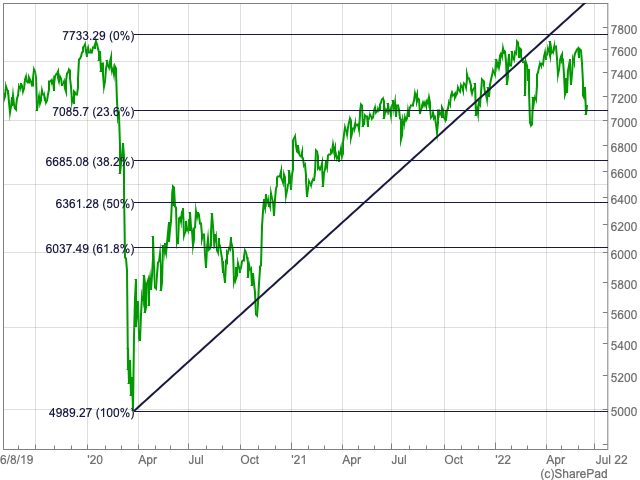The FTSE 100 is currently down 3.6% so far in 2022 and although the losses of the last month will be hard to stomach, those with a UK Blue Chip oriented portfolio will have fared better than those with a more global approach.
The strong weighting towards commodities has meant that the FTSE 100 has provided relative safety compared to overseas markets, especially the United States.
With such a strong weighting in highly valued technology shares, the S&P 500 is down 23% this year and the Tech-focused Nasdaq has shed 32%.
Indeed, the FTSE 100 is being seen a defensive play due to the exposure to miners, oil giants and pharmaceutical companies.
However, the FTSE’s outperformance doesn’t mean London’s leading index has been immune, or will be immune, to global monetary policy tightening with a backdrop of a cost of living crisis caused by soaring inflation.
How far could the FTSE 100 fall?
With equity markets in freefall this week, investors will be questioning just how far can the FTSE 100 fall? The basis of the question will depend on a combination of economic outlook, and both technical and fundamental analysis.
The economic outlook would suggest we have some way to go. Investor sentiment is souring with numerous predictions of recession and a Federal Reserve that seems intent on making sure the US gets there. A US recession will have global implications.
The Bank of England has been criticised for moving to slowly by not raising rates sharply enough to fight inflation, but they are walking a tightrope with deteriorating economic conditions caused by high prices on one side, and a recession induced by higher interest rates on the other.
The situation is similar in Europe while China is fighting COVID with economic lockdowns hampering global growth.
Company Earnings
How much of the bad economic news is already priced into market will become pronounced in the upcoming round of earnings from global companies.
The first signs of stress are visible in lay offs by US companies. US tech companies have been letting workers go at an alarming rate in recent months with Coinbase shedding 18% of their work force and Tesla cutting 10% of workers.
The problem is very different in the UK in that companies can’t secure the people they need. This is increasing wages and denting margins, adding to pressure from rising prices and supply chain disruption.
This was highlighted just this morning by Tesco CEO Ken Murphy as he said “we are seeing some early indications of changing customer behaviour as a result of the inflationary environment. Customers are facing unprecedented increases in the cost of living.”
How much is priced in?
Investors are quick to price negativity into markets and there is a school of thought that any upcoming economic contraction is already priced into stocks.
In addition, the FTSE 100 is dominated by commodity companies that are doing rather well in the current climate. BP and Shell posted bumper profits recently and the dynamics of oil and gas markets means the two are currently enjoying very favourable refining margins.
So while investors are dumping housebuilding shares for fear of a slowing UK economy and housing market caused by higher rates, London’s largest companies by capitalisation are likely set to produce significant profits in the coming months.
Shell’s market capitalisation is 8x the combined valuation of the FTSE 100’s house builders which will more the offset any downside in the UK housing market.
UK banks are also a major beneficiary of higher rates and will enjoy higher net interest margins.
As demonstrated in these examples, the FTSE 100 is not a representation of the UK economy, and the fundamentals for a large proportion of FTSE 100 companies will navigate any economic downturn just fine.
The FTSE 100’s inverse relationship with the pound will also provide support as GBP/USD trades near the lows of 2020.
Nonetheless, should general investor sentiment continue to worsen, we will likely see further short term downside in shares. This is where FTSE 100 technical analysis will come into play as equity prices are dictated by psychology and historical price action.
FTSE 100 key levels
The key levels to note are the major psychological level of 7,000. Should this be broken, traders will be eyeing 2022 lows around 6,800.



If we see a break of 6,800 the next major level is 6,685 and the 38.2% Fibonacci Retracement from the rally that began in 2020 after the COVID selloff. After this, bears will look for 6,361 then the next major psychological level of 6,000.
It is important to remember that markets can, and very often will , move a lot further than you think they will.
